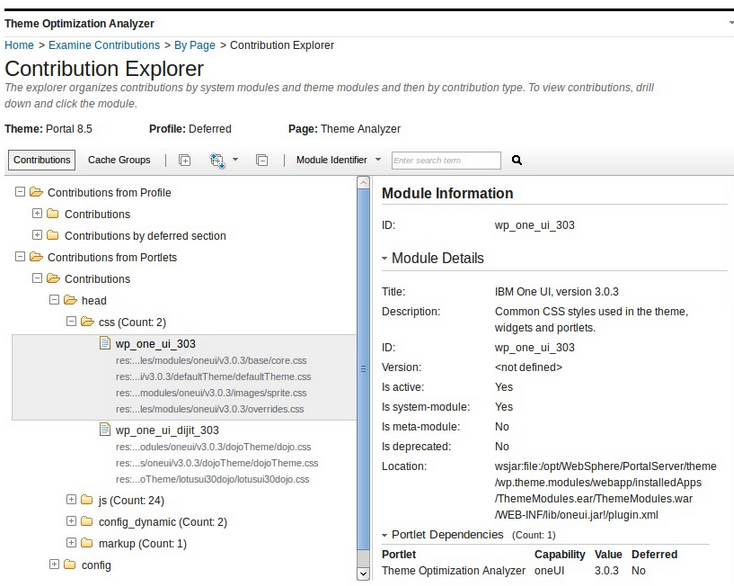Examine contributions - Theme Analyzer
Explore contributions and subcontributions defined as part of modules, and view Reference Identifiers.
Contributions by profiles
From the section...
-
Examine contributions by profiles
...select a profile in the Select Profile screen, and then advance to the Contribution Explorer to explore the contributions in that profile.
The Select Profile screen displays the themes and their profiles in the tree view and shows details on the selected branch in the details view. The tree view also shows in parentheses which theme and profile is the default. The details view shows the location of the profile JSON file. After selecting a profile, the Contribution Explorer screen displays.
All contributions
Select...
-
Examine all contributions section
...to explore all contributions provided by modules available with the system, theme, or both. Select a theme or the system module branch in the screen. The Select Theme screen displays a system modules branch and all themes in the tree view. To view the contributions in a theme, double-click the theme or select the theme and click Next.
Contribution explorer
The contribution explorer displays the contribution type hierarchy of the system in a split view. The tree view shows the contribution and subcontribution types with modules as the leaf, the details view shows details on the selected module from the tree view. We can get to the contribution explorer from different paths in the UI.
- When we examine the contributions scoped by profile, we have two root branches:
Contributions The root for all contributions provided by modules in the non-deferred section of the profile. Contributions by a deferred section The root for all contributions provided by modules in the deferred section of the profile. 
- When we examine the system and theme contributions, we have one or two branches:
Contributions by System Modules Contains all contributions provided by modules defined globally through a plugin.xml file. Contributions by Theme Modules Contains all contributions provided by modules defined within the themes contribution folder as part of the JSON files. This branch is only shown when a theme is selected. 
When we expand a tree or branch, if it is large and takes more than 30 seconds to expand, the expansion process is stopped. Expand those branches individually.
The details view displays the details for the selected module such as:
| ID | Displays the module ID. |
| Version | Displays the module version, if one was defined. |
| Is system-module | Yes if the module is globally defined through a plugin.xml file. |
| Is meta-module | Yes if the module does not contain any contributions, but instead contains only prerequisites. |
| Is deprecated | Yes, if the module was deprecated. |
| Location | Displays the file path for the module. |
| Capabilities | Displays all capabilities for the module. |
| Prereqs | Displays all prerequisites for the module. |
| Parents | Displays all parent modules for the module |
| Contributions | Displays all contributions by contribution and sub contribution. The resources are elements that can be clicked, which open a new window and serves the resource in the browser when clicked. In simulation mode, the resources cannot be clicked. |
Search within the contribution explorer
Use the search bar to search the tree view and the details view for various information. The following search scopes are supported:
| Module Identifier | Search for a specific module by name. For example, wp_client_main. |
| Resource | Search for the module that exposes a certain resource. For example, enter master.css to identify the module that exposes this resource. This search is useful if you find an error in a JavaScript file in the browser. We can find the module that this resource belongs to. |
| Capability | Search for the modules associated with a specific capability. For example, to know which module provides the dojo capability. Then, you know which module add as a prerequisite for our own module. |
| Reference Identifiers | Search for which dynamic content spot or module reference is exposed by which module. |
Enter a term into the search field in the toolbar, and press Enter or click the Find icon. The found item is then highlighted for a short time with a yellow background. Pressing Enter again or clicking Find icon again will find the next item. If no item is found, either a pop-up dialog opens to instruct us to start the search from the beginning or the background of the search field is marked in red.
Cache groups
For every combined request the theme optimization framework produces, we can see the overall ability to cache that request and how those caches are calculated. We can select a cache group or resources and examine it.
Parent Theme Optimization Analyzer